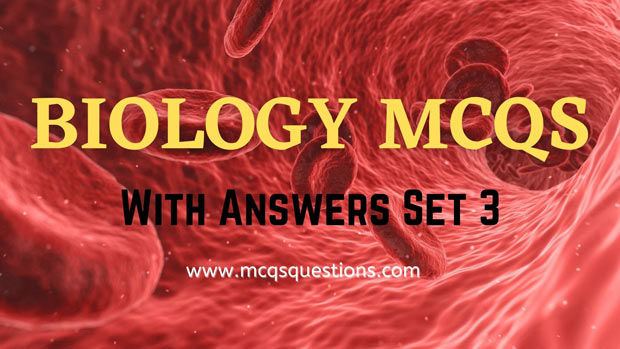Biology MCQs with answers set 3. Biology MCQs set 3 contains 30 multiple choice questions about the topics introduction to biology, different branches of biology, relationship of biology to other sciences and levels of organization. These questions are very useful for a 9th class student to an M.Phil student. By preparing these mcqs, you can prepare and appear any PPSC job test related to biology. This is the third set of our biology series in which we have included questions from all the basic levels of biology. These questions are taken from the first chapter of the ninth grade biology textbook. This set is also the last set of biology class 9 chapter 1. We will similarly include questions from basic to advanced levels in the next sets.
Biology MCQs With Answers Set 3
1. Zoology deals with the study of _____?A). Plants
B). Animals
C). Atom
D). Cell
View Answer
2. The scientific study of Plants is called _____?
A). Botany
B). Zoology
C). Anatomy
D). Histology
View Answer
3. Economically study of animals called _____?
A). Biophysics
B). Bioeconomics
C). Biogeography
D). Biochemistry
View Answer
4. Study of drugs and their effects on the human body is called _____?
A). Anatomy
B). Physiology
C). Pharmacology
D). Histology
View Answer
5. The study of the molecules of life is called _____?
A). Immunology
B). Physiology
C). Anatomy
D). Molecular Biology
View Answer
6. The branch of biology which deals with the study of nucleic acid is called _____?
A). Taxonomy
B). Molecular biology
C).Socio-biology
D). Embryology
View Answer
7. Allah made every living thing from _____?
A). Water
B). Soil
C). Air
D). Fire
View Answer
8. Reproductive organ of the Plant is _____?
A). Root
B). Stem
C). Flower
D). Leaf
View Answer
9. The number of bio elements in nature is _____?
A). 13
B). 14
C). 15
D). 16
View Answer
10. An example of Unicellular is _____?
A). Frog
B). Horse
C). Euglena
D). Rabbit
View Answer
11. An example of the organ is _____?
A). Carbon
B). Stomach
C). Electron
D). Neuron
View Answer
12. An example of bio-molecule is _____?
A). Iodine
B). Chlorine
C). Proton
D). Protein
View Answer
13. How many elements make 99% of the total mass?
A). Four
B). Ten
C). Eight
D). Six
View Answer
14. Organelles assemble to form _____?
A). Cells
B). Tissues
C). Systems
D). Organ
View Answer
15. An example of Bioelement is _____?
A). Bromine
B). Cobalt
C). Carbon
D). Aluminium
View Answer
16. The element that makes 3% of the total mass of a living organism is _____?
A). Oxygen
B). Carbon
C). Hydrogen
D). Nitrogen
View Answer
17. Epidermal tissue is found in _____?
A). Pigeon
B). Sparrow
C). Onion
D). Crow
View Answer
18. The part of the earth where communities of living organisms exist is called _____?
A). Ecosystem
B). Biosphere
C). Population
D). Habitat
View Answer
19. Which of these does not represent a unicellular organization?
A). Amoeba
B). Volvox
C). Paramecium
D). Bacteria
View Answer
20. An example of Volvox is _____?
A). Brown alga
B). Blue-green alga
C). Red alga
D). Green alga
View Answer
21. Frog has two eyes, each of which has _____?
A). One eyelid
B). Two eyelids
C). Three eyelids
D). No eyelid
View Answer
22. An example of the multi-cellular organism is _____?
A). Frog
B). Euglena
C). Amoeba
D). Bacteria
View Answer
23. Scientific name of pea plant is _____?
A). Homosaplens
B). Pisum Indicum
C). Dilbergia Sisso
D). Pisum Sativum
View Answer
24. Euglena is an example of _____?
A). Acellular
B). Unicellular
C). Multicellular
D). Colonial
View Answer
25. If a scientist is studying the methods of inserting human inserting genes in bacteria, which branch of biology may this be _____?
A). Pharmacology
B). Physiology
C). Biotechnology
D). Anatomy
View Answer
26. Which one will be the correct sequence of the levels of organization of life?
A). Molecule, organelle, cell, tissue, organ, organ system, individual
B). Cell, organelle, molecule, organ tissue, organ system, individual
C). Organ, organ system, individual, cell, organcell
D). Molecule, tissue, organelle, cell organ system, organ, individual
View Answer
27. Which of the following group includes organisms of all which are absorptive in the nutrition?
A). Bacteria
B). Animals
C). Protists
D). Fungi
View Answer
29. Which of these tissues also make the glandular tissue in animals?
A). Connective tissue
B). Epithelial tissue
C). Nervous tissue
D). Muscular tissue
View Answer
30. When we study the feeding relations among different animal species of a forest, at what level of organization we are studying _____?
A). Community
B). Biosphere
C). Population
D). Individual
View Answer

About the Author
My Name is M. Zahid, I have master degree in Computer Science. Currently I am working as an Information Technology Teacher in Govt sector of Pakistan.
Blogging is my passion and I try my best to deliver some useful contents on our blogs for my res…